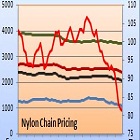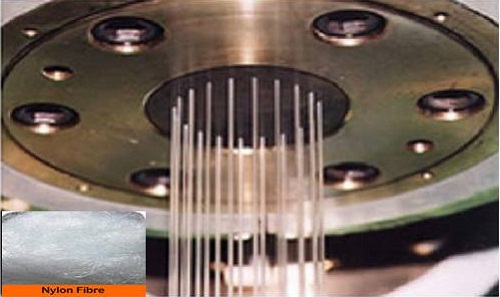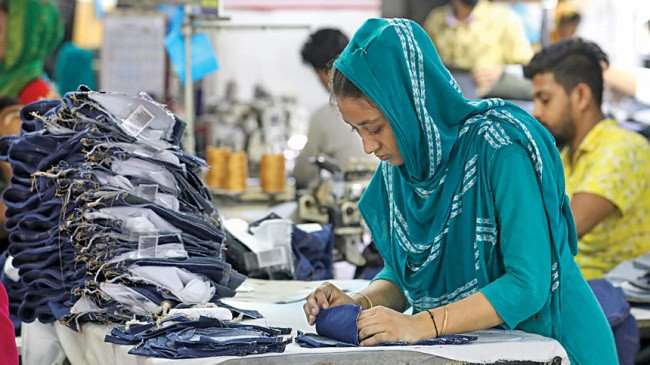FW
India as a textile brand has not established itself in Russia yet. More than 90 per cent of textiles and apparel consumed in Russia are imported. This gives Indian manufacturers a huge opportunity. Russian consumers are trendy and quality-conscious. Most global brands have experienced exponential growth since 2000 in Russia. E-commerce is the next big thing and consumers are ready to pay the price for latest brands, trends and service.
Russia is a quality conscious market. The middle class continues to grow and consumer’s expectations are more focused on quality, brands and emotional value attached to the product. Unlike other markets, price points are always the last concern in Russia. Due to the baby boom, children’s wear segment has been seeing great demand in the last decade. However, there is great potential in men’s wear, women’s wear, corporate wear, industrial wear and sport’s wear.
The Russian textile market is undergoing changes. These changes are taking place both in the purchasing structure and distribution channels. It requires a lot of effort and attention to set up an organisation in Russia but it is a market with a lot of potential and new opportunities.
Morarjee Textiles has opted for a sustainable design for its Nagpur factory. It aims to address both human and environmental challenges facing the country’s textile industry. The innovative building will reduce energy and water use. Morarjee Textiles works almost exclusively in high quality cotton for overseas markets with a significant proportion of the output being either printed or dyed.
The structure is designed to use the least material possible and provide a world-class environment for the 600-odd people who will work at the factory. Since textiles are a water and power intensive industry, the company’s aim is to channel all waste into a circular or closed loop system in order to get as close to zero waste as possible.
While conventional industrial systems tend to be simple, linear and wasteful, employing long-term toxins, biological systems are generally complex, interconnected, and have closed loop flows of resources that don’t cause long-term damage to the environment. The design team has used biomimicry as a tool with which to rethink the textile process and devise solutions that should provide for long term value creation.
A strict north-south orientation for the building has been chosen, allowing for roof lights with glazing facing north providing generous amounts of natural light throughout the working environment while the sloping solid surfaces of the roof lights are perfectly oriented for photovoltaic panels.
www.morarjee.com/
Blue jeans can now be eco friendly as scientists have invented engineered bacteria that can produce indigo dye for denim. Blue jeans get their signature color from indigo dye. Producing indigo releases chemicals that can pollute water and harm fish. That’s prompted scientists to seek cleaner methods. One new approach uses bacteria to produce indigo using a chemical process found in living plants.
For centuries textile makers have been using a deep blue dye made from a plant. The plants’ leaves don’t store indigo but contain a related compound. Crushing the plants’ leaves releases the molecule. Then it’s free to react with oxygen in the air and pair with another of its kind to produce that prized indigo.
People used to make the blue dye by extracting it from plants. But as demand for the dye grew, so did chemists’ know-how. By the late 1800s, German scientists had figured out how to synthesisze indigo from chemicals in the lab. Their plant-free approach was faster and allowed for factories to make huge amounts. Today, factories churn out some 40,000 tons of indigo per year, just for blue jeans.
But this large-scale production of the dye has its challenges. Wastes produced by the dye-making haven’t been kind to the environment. Most fabric coloring takes place in water. Yet indigo dissolves poorly in water. To get around this problem, factories use chemicals called reducing agents. These chemicals convert indigo into a form that can dissolve in water. However reducing agent can hurt aquatic life.
Century Textiles & Industries has posted a net loss of Rs 29.01 crores for the quarter ended June 30. For the same period last year, its net profit was Rs 66.49 crores. In the quarter ended June 2015, sales shot up 5.59 per cent to Rs 1,944.72 crores, while in the previous quarter ended June 2014, it was Rs 1,841.83 crores. The textile division clocked in a turnover of Rs 445.32 crores in Q1 FY16 as against Rs 429.89 crores in the same period last year.
It may be recalled that the Competition Commission of India (CCI) had upheld the complaint of alleged cartelisation against cement manufacturing companies including Century Textiles. Century Textiles had to pay a penalty of Rs 274.02 crores, imposed by CCI. Century had meanwhile filed an appeal against the order before the Competition Appellate Tribunal (COMPAT). The COMPAT granted a stay on the CCI order on condition that the company deposits 10 per cent of the penalty, which amounts to Rs 27.40 crores. The company deposited the amounte during 2013-14.
Confirming its plans for ITMA Milan, Karl Mayor has said the firm will launch at least seven new warp-knitting machines in the international textile machinery fair. Karl Mayer feels launch at the leading trade show will help it catch more eyeballs from international buyers, and, in return, will help it to write a success story for the new innovations. The fair is considered the most important international meeting point for the industry. The machines will be showcased under the banner, ‘We care about your future’ on the 1,400 sq metre stand.
Optimistic over the company’s plans, Oliver Mathews, Director (Sales), Warp Knitting Business Unit, said that their products are so efficient and technology-driven that visitors will not resist from seeing their business making a mark with the help of them. The range intended to bring maximum benefits for users will strengthen their position as a market and technology leader in the industry.
The company’s optimism is supported by the fact that it has been successful in the past also in making good fortunes out of the launches pretty similar to this. Four years ago, the firm in ITMA Barcelona had launched the finest ever version of its HKS 2-3 E tricot warp knitting machine, which went to become a best seller for it.
At the next edition of Première Vision Paris, specialized Upper Jeanswear area, Eco Denim will present its sportswear and jeanswear collection made of pants, jackets, shirts, shorts, skirts, dresses. In each of its collections, the manufacturer will introduce new washing and design techniques combined with denim innovations and the latest trends.
Eco Denim is a vertically integrated company offering technological innovations in fields ranging from patterns, sewing, washing, all types of dyeing and special treatments, embroidery, laser to ozone treatment. All processes are 100 per cent controlled in-house, in one production site.
The company will bring some of its novel technologies to Paris including different dyeing machines, new techniques and also special prints and treatments on fabric rolls. Upper Jeanswear at Pemiere Vision, the updated jeanswear concept dedicated to fashion brands will present a complementary offer of weavers and manufacturers.
www.premierevision.com
South Korea’s emerging labels Munsoo Kwon and J Koo won the Asia finals of International Woolmark Prize 2015-16 the men’s wear and women’s wear categories held in Shanghai. Selected from 12 promising fashion talents in Asia, both winners earned A$50,000 in prize money, and will take part in next year's international finals.
This year's panel of judges consisted of a cross-section of industry leaders, including designer Thom Browne, Chinese supermodel Lu Yan and Cyril Rahon, head buyer of 10 Corso Como. Women’s wear category winner Jinwoo Choi and Yeonjoo Koo of J Koo showcased an oversized denim jacket paired with matching trousers. The pair's innovative fabric development transformed the material with artful use of bleach and strategic fraying to add to the illusion.
Men’s wear winner Munsoo Kwon displayed a well-tailored suit that proved new ways of working with wool. Traditional pinstripe suiting was transformed into a modern look with white ombré along the sleeves and trouser legs. The final for menswear will be held in Florence in January 2016, and the womenswear final will take place in New York in February next year.
www.woolmark.com
The four-day Sourcing at Magic fair starts from August 16 at Las Vegas. The show will represent more than 1,000 apparel, accessories, footwear and home textile resources, along with a range of some 200 fabrics, based out of about 43 countries. During the event, seminar series will be held keeping in mind special features, needs and interests of that particular area. The second day of the event will see Apparel Magazine taking part in the ‘Sourcing Summit at Magic. A session on apparels with a theme of Sourcing’s Emerging Role-Achieving Breakthroughs From Concept to Delivery, will carry out an executive research summary from its 9th Annual Apparel and Kurt Salmon Sourcing Survey.
The event will see special emphasis on wearable technology, home sourcing and buzz boutique. Wearable technology comprises of prototype garments, stretchable electronics screen printed onto textiles and compression shirts with integrated dry electrodes for electrocardiogram monitoring. The concept of ‘Home sourcing at Magic’ is devised to integrate the fashion and home communities. It will see the participation of more than 50 countries. The model of ‘Buzz Boutique’ will stress on marketing solutions, apps and social media trends.
Global artisans will showcase their unique and culture-based products from the countries such as Philippines and Indonesia.


Benzene prices went up in February till April and after that, remained sluggish till June this year. Caprolactum, which had been following benzene values, lagging behind by only a month, continued doing so. Contract prices for benzene in the US plunged 21 per cent to $2.25 per gallon. The equivalent contracts in Europe also declined 14 per cent to €707 a ton. Spot prices, meanwhile moderated in early June, then jumped in the second week and fell again in the third week, finally bouncing in the last week across regions.
Asian markets remained strong
The Asian markets tracked firmer downstream styrene monomer and had active discussions. Asian marker, the FOB Korea gained 5 per cent in June, but was down but 40 per cent on the year. Prices had touched a 12-month low in January to just above US$600 a ton. Since then, it has recovered about US$200 a ton till June.
In Asia, caprolactam prices eased last month, which was driven by falling benzene prices and lusterless demand by the end of June, particularly from the textile filament sector. As demand was disappointing, several caprolactum units decided to shut for maintenance over the next two months this may balance out the weak demand. As for Europe, the May caprolactum contract was settled at an increase of
Demand for Nylon filament yarn dips
In late May, demand for nylon filament yarn began to dip, showing that the busy season was over earlier than expected and normal business cycles had emerged. Thus, prices dipped last month as the cost of raw material eased with lower caprolactum and nylon chips prices, and lack of demand. Downstream converters faced liquidity issues and limited fresh order intakes. As downstream sectors had entered the seasonal lull, nylon FDY markets swayed from stable to weak.
US too was struggling in the nylon filament segment, with slow demand and polyester as a substitute in some applications. The pressure from polyester was experienced by both markets.
Austrian company Andritz operating in over 250 places worldwide, provides full lines and individual solutions for spun lace, wet laid, needle punch, bonding and finishing for spun bond applications. In the spun lace, for direct or cross lapped lines, Andritz focuses on high performance with regard to productivity, fabric quality, process reliability, and energy consumption.
In needle punch sector, Andritz nonwovens products generate high value added. For both light and heavy fabrics, Andritz neXline needle punch optimizes the production rate of every individual machine along the line, providing higher tensile strength and greater evenness.
The in-house expertise of Andritz through-air dryer technologies and in developing high performance systems brings new process solutions to the spun lace industry.
Andritz is also a system supplier of complete wet laid nonwoven lines for innovative and versatile end uses in hygiene, medical, and technical product ranges. The Andritz wet lace process is suited for production of flushable, dispersible, and 100 per cent biodegradable wipes.
www.andritz.com/












